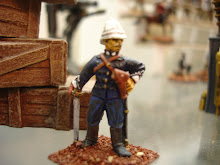So, this is a basic multi-part "how I did it" for the rivers. I have a few pictures to go with, as well, though they are of different pieces.
Just to re-cap, I am using the styrene sheet rivers from a company called Precision Products [www.appliedimaginationinc.com]. The sheets are 16"square, 0.025" thick, with vacuum-formed terrain impressed into the sheets. The stream is about 1" (2.5 cm) across, with banks of about equal width.
Materials and tools: wood putty, styrene rivers, kitchen shears, hobby knife, 1/16" thick plywood, glue, felt, a few heavy books
- Cut out the river piece. I cut mine all the way to the edge of the banks, but you could leave a small lip or flange of plastic around it. I used kitchen shears to cut them out.
- Wash the piece in warm water with some dish detergent, just to make sure there's no mold release on it.
- Mix the wood putty. I used to have Durham's, which I actually prefer, but the DAP brand stuff works as well. You want to mix water with the powder until it gets like a really thick milkshake consistency.
- Fill the underside of the river piece with the wood putty and let it dry overnight.
- Next day, trace the shape of the river out onto some thin plywood or MDF. I use 1/16 inch birch plywood (about 1.5mm), that is supposed to be for R/C airplanes or something.
- Cut the shape out. A bandsaw with a fine-tooth blade would be perfect for this, but I don't have one, so I use my hand jigsaw (sometimes called a fret saw or jeweler's saw, I think). Sand the rough edges.
- Glue the river piece to the base. I use Allene's Tacky Glue usually, but I have also used superglue (liquid, not gel) with good results.
- Clamp or weight down the piece and leave two+ hours (PVA) or twenty-ish minutes (superglue). I have tried lots of ways to weigh it down, and I am still least happy with this step of the process. Best so far has been a layer of felt or something, then a few large heavy books on top. It still leaves a few gaps at the edges, though.
- Spray with flat white paint. I tried black paint on one piece. It doesn't work for me. Let dry (duh!).

At this point, you should have a piece of nicely detailed river, with the hollows filled and attached to a base for a nice, weighty, durable piece of terrain.
Next post, I'll discuss painting and filling the stream with water effect.


2 comments:
Excellent article.
I gave your blog a mention on mine and provided a link to it.
Have you tried our Terrain Putty?
Thanks for your interest and support.
No, I haven't seen the Terrain Putty. I suppose now I need to drop by your blog and see what you have! Woohoo! Always like to see new stuff out there.
Post a Comment